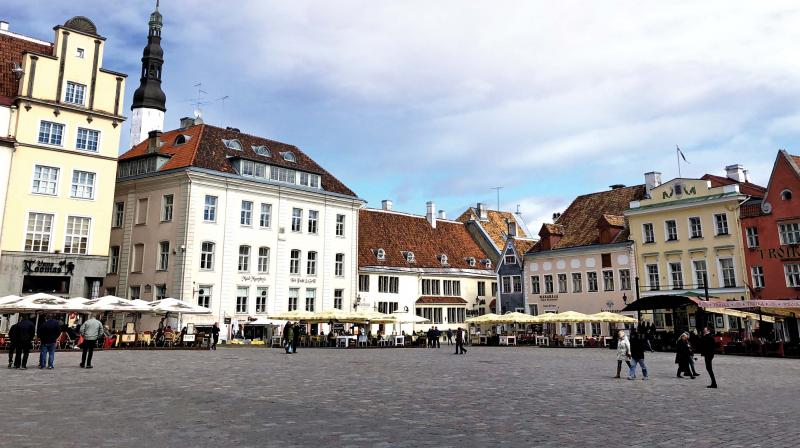Estonia, where time stands still: Travel enthusiast

Estonia is not just the land of cathedrals, castles and medieval citadels. It’s also a land of forests, lakes, bogs, swamplands and rivers. Over 50 % of the country is covered with forests and makes one want to drive into the country rather than just visit the capital Tallinn.
Having been conquered and ruled by the Danish, Swedish, Germans and the Russians, Estonia only regained Independence as recently as 1991 after the collapse of the Soviet Union. Old Town Tallinn, with its red roof tops, squares, steeples and cobbled streets is a prime example of Medieval Europe. The best way to see the Old Town is on foot and I took one of the free walking tours conducted by some very well informed young student guides
One can spend days exploring the Old town, but for me a few hours is more than sufficient .I made a beeline to the less touristy districts Kalamaja, the bohemian Mecca of Tallinn and Telliskivi, the creative city. Located in a former industrial complex, I found innumerable eating and drinking places, photo galleries, boutiques, quirky stores and not to forget a large number of very interesting and kitsch street art.
It’s a crime not to head out of Tallinn to explore more of this gorgeous country. Renting a car, my next stop was Narva, 235kms from the capital, stopping at the highest waterfall in Estonia, Jagala and also “Viru Raba”, one of the most accessible bogs in Estonia. There is a 3.5 kms walking trail and it takes you through dark murky water and I promise you fantastic photo opportunities.
I also visited Sillamae, an old Stalinist city, which was once a nuclear weapons facility and wears a deserted look now but presents an interesting peep into the not so distant past. Narva a very significant city, although you will hardly see any tourists there, is situated by the Russian border and is home to most of Estonia’s Russian population. Two dramatic architectural marvels on opposite banks of the River Narva, one belonging to Estonia and one to Russia vie for attention. The Estonian Castle of Order of Germanic Knights and the Russian fortress of Ivangorod are a sight to see when lit up at night.
The next day is an easy drive to the university town of Tartu, making pitstops at the mighty Lake Peipus and the elaborate Orthodox Puhtitsa convent. Lake Peipus is the fifth largest lake in Europe and is home to The Old Believers, a group of people who fled Russia in the 17th Century to avoid religious persecution and still maintain their old traditional ways.
Tartu is the oldest city in Estonia and seamlessly integrates the old and the new. It is a pretty town filled with historic buildings, relaxing parks and quirky sites too. Not to miss is the Leaning House, which sits in the main Town Hall Square. This once sinking house has a very noticeable lean with a gradient of 5.8 degrees, which is more than that of the Pisa Tower. Another must see is the St John’s Church. This Gothic brick building is unique on a pan European scale. Decorated with 1,700 unique terracotta sculptures on the inside and outside, I have never seen a church with so much character.
Heading to the Parnu, Estonia’s most famous beach resort town, windy rainy weather greeted me and was not conducive for any outdoor activity. I drive my car onto a humongous ferry that is only a 25-minute ride to Muhu and Saaremaa Islands. Cars, buses, trailers etc. are all effortlessly driven onto this ferry and this is the only way to get to these islands.
Muhu, the smaller of the two islands, is connected to Saaremaa by a beautiful bridge with open waters on either side making for a spectacular drive. There are a number of interesting things to see and do on these islands other than the regular beach activities in summer .The Timber Windmills of Angla in the middle of fields seem out of place but make for an interesting visit to give you an insight into the bygone farm life on the island.
The very bizarre Kaali meteorite craters are most fascinating. According to various estimations, these carters are 3,500-7,500 years old. The largest of these carters was formed when a large piece weighing 20-80 tons crashed into earth at a speed of 10-20kms per second. In ancient times this carter/lake was considered a sacred body of water and a sacrificial site.
Time stands still in the fishing village of Koguva. The beginnings of the village can be traced to 1532, while the dwellings are only some 200 years old .It is like a fairy tale village with the green moss covering every inch of the village stone fence. Tiny dwellings, so quaint and pretty, one can witness the remarkable examples of Estonian peasant architecture. A reminder of how life was not very long ago .The un-spoilt quietness of that village is still tugging at my heart.
I was able to spend an unhurried seven days in Estonia, crisscrossing this breathtaking country. Each corner of Estonia is different. The islands offer a totally different experience than the expansive forests. Tallinn’s medieval Old Town is steeped with history while the waterfront Kalamaja has intimate vinotheques, alternative art cafes and music events. Once in Estonia you are only a stone’s throw away from Latvia and Lithuania.
(Meenakshi S. is a travel and car enthusiast who did a road trip from Coimbatore to London in 2017)

